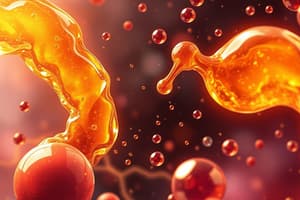Podcast
Questions and Answers
Explain the key chemical properties of fatty acids mentioned in the text.
Explain the key chemical properties of fatty acids mentioned in the text.
The key chemical properties of fatty acids include their hydrophobic nature, insolubility in water but solubility in organic solvents like chloroform, ether, and benzene, and their classification into saturated fatty acids (SFA), monounsaturated fatty acids (MUFA), and polyunsaturated fatty acids (PUFA).
Describe the structure, properties, and function of triacylglycerol as outlined in the text.
Describe the structure, properties, and function of triacylglycerol as outlined in the text.
Triacylglycerol, also known as triglycerides or neutral fat, is a type of simple lipid that consists of esters of fatty acids with glycerol or other higher alcohols. Its structure includes three fatty acid chains attached to a glycerol backbone. Triacylglycerol serves as a major form of energy storage in the body.
Classify phospholipids and enumerate their functions according to the text.
Classify phospholipids and enumerate their functions according to the text.
Phospholipids are classified as compound lipids and are characterized by the presence of a phosphate group. Their functions include serving as important components of cell membranes, contributing to the fluidity and permeability of membranes, and participating in cell signaling and other cellular processes.
Identify the major classes of lipids and describe their biochemical functions based on the text.
Identify the major classes of lipids and describe their biochemical functions based on the text.
Outline the general features of the fluid mosaic model of the structure of biological membranes as mentioned in the text.
Outline the general features of the fluid mosaic model of the structure of biological membranes as mentioned in the text.
What is the chemical nature of lipids?
What is the chemical nature of lipids?
Which of the following is not a simple lipid?
Which of the following is not a simple lipid?
What type of esters are compound lipids?
What type of esters are compound lipids?
Which organic solvents are lipids soluble in?
Which organic solvents are lipids soluble in?
What are the major classes of lipids?
What are the major classes of lipids?
Which of the following is classified as a compound lipid?
Which of the following is classified as a compound lipid?
What type of esters are found in simple lipids?
What type of esters are found in simple lipids?
In which organic solvents are lipids soluble?
In which organic solvents are lipids soluble?
What is the key chemical property of fatty acids?
What is the key chemical property of fatty acids?
Which of the following lipids is a subclass of compound lipids?
Which of the following lipids is a subclass of compound lipids?
Flashcards are hidden until you start studying




